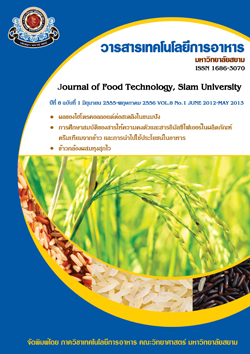การศึกษาสมบัติของสารให้ความคงตัวและสารอิมัลซิไฟเออร์ในผลิตภัณฑ์ครีมเทียม จากข้าวและการนำไปใช้ประโยชน์ในอาหาร
Main Article Content
Abstract
การพัฒนาผลิตครีมเทียมเหลวจากข้าว โดยศึกษาชนิดของข้าว 2 สายพันธุ์ คือ ดอกมะลิ 105 และชัยนาท 1 เปรียบเทียบวิธีการโม่แป้งแบบเปียกและแบบแห้ง พบว่าวิธีการโม่แห้งให้ปริมาณโปรตีนและไขมันมากกว่าวิธีการโม่เปียก จึงคัดเลือกวิธีโม่แห้งในการเตรียมสารละลายน้ำนมข้าว โดยแปรผันชนิดและปริมาณของสารให้ความคงตัว คือ carboxy methyl cellulose (CMC) ที่ระดับความเข้มข้นร้อยละ 0.05, 0.1, 0.15, 0.2, 0.25 และ 0.3 ตามลำดับ และ locust bean gum (LBG) ที่ระดับความเข้มข้นร้อยละ 0.10, 0.20 และ 0.30 พบว่าที่ระดับความเข้มข้นของ CMC ร้อยละ 0.05 และ LBG ร้อยละ 0.17 ให้ค่าความหนืดของน้ำนมข้าวเท่ากับ 128.33 cP ใกล้เคียงกับค่าความหนืดของนมผสมต้นแบบ (130 cP) เมื่อทำการพัฒนาสูตรที่เหมาะสมโดยวางแผนการทดลองแบบ Mixture design พบสูตรที่ดีที่สุดในการผลิตครีมเทียมจากข้าวที่มีส่วนประกอบของน้ำนมข้าว, น้ำมันราข้าว, CMC, LBG ในปริมาณร้อยละ 87.23, 10.48, 0.04, 0.14 และ N-CREAMER 46 และ TWEEN 20 ที่ใช้เป็นสารอิมัลซิไฟเออร์ในปริมาณร้อยละ 2.10 และ 0.42 ตามลำดับ เมื่อวิเคราะห์คุณสมบัติทางเคมีกายภาพพบว่าเป็นอิมัลชันชนิด oil in water (o/w) ที่มีการกระจายของขนาดอนุภาคเท่ากับ 5.81 μm. มีค่าความหนืดเท่ากับ 131.67 cP ค่าความคงตัวของอิมัลชันและตะกอนอ่อนเท่ากับร้อยละ 100 เช่นเดียวกันตามลำดับ เมื่อพัฒนาใช้ในผลิตภัณฑ์ต้นแบบ เครื่องดื่มเย็นรสโกโก้ เปรียบเทียบความเข้มข้นของปริมาณน้ำตาลที่ร้อยละ 50, 60 และ 70 พบว่าที่ระดับความเข้มข้นร้อยละ 60 ให้คะแนนการยอมรับโดยรวมสูงสุดอยู่ในช่วง 6-7 โดยไม่พบความแตกต่างทางสถิติ (p>0.05) ของชนิดสายพันธุ์ข้าวในด้านกลิ่นรสและเนื้อสัมผัส และพบจุลินทรีย์เริ่มต้นทั้งหมดน้อยกว่า 30 cfu/g และไม่พบการเจริญของเชื้อ E. coli ตามลำดับ
Study on the Properties of Stabilizers and Emulsifier in Nondairy Creamer from Rice and Food Application
Two types of rice as Dok Mali 105 and Chai Nat 1 were studied to develop nondairy cream. Extraction methods (dry and wet mills) of rice were investigated and compared for the present study. Higher protein and fat contents were higher in dry-mill than in wet-mill method. The dry-mill method was selected to prepare the rice milk in this study. Types of stabilizer (carboxymethylcellulose and Locust bean gum) were determined varied at different concentrations. Concentration of carboxy methylcellulose (CMC) was prepared at 0.05, 0.1, 0.15, 0.2, 0.25 and 0.3% (w/w) and concentration of locust bean gum (LBG) was prepared at 0.10, 0.20 and 0.30% (w/w). It showed that the viscosity (128.33 cP) of 0.05% (w/w) of CMC and 0.17% (w/w) of LBG was similar to that of milk protocol, which was 130 cP. The optimal formula obtained from Mixture Design Experiment for production of rice cream was formula consisting of rice milk, rice bran oil, CMC, LBG at 87.23, 10.48, 0.04, 0.14 and emulsifier of N–CREAMER 46 and TWEEN 20 at 2.10 and 0.42% (w/w), respectively. Physiochemical properties of rice cream indicated that emulsion of rice cream studied was oil-in-water (o/w) emulsion. Its particle size distribution and viscosity was 5.81 μm and 131.67 cP, respectively. Stability of emulsion was 100% (w/w). The rice cream obtained was applied in food model, e.g., instant cocoa powder beverage. In addition, concentration of sugars at 50, 60 and 70% (w/w) were used in the instant cocoa powder. In this experiment, we found that the score of overall acceptance of the cocoa beverage added with rice milk and 60% (w/w) of sugar was significantly high (6-7) and there was no significantly effect on odor and texture properties of rice with different types (p>0.05). Total microorganism was detected less than 30 cfu/g and no E. coli was observed in this study.
Article Details
Copyrights of all articles in the Journal of Food Technology available in print or online are owned by Siam University and protected by law.


